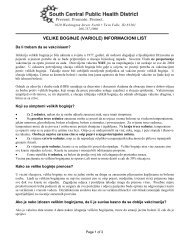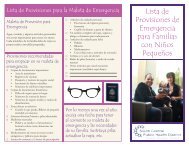Physical Activity Pyramid for Young Children
Physical Activity Pyramid for Young Children
Physical Activity Pyramid for Young Children
- No tags were found...
You also want an ePaper? Increase the reach of your titles
YUMPU automatically turns print PDFs into web optimized ePapers that Google loves.
<strong>Physical</strong> <strong>Activity</strong><strong>Pyramid</strong><strong>for</strong> <strong>Young</strong> <strong>Children</strong>64Color Me Healthy...preschoolers moving and eating healthy
<strong>Physical</strong> <strong>Activity</strong> <strong>Pyramid</strong><strong>for</strong> <strong>Young</strong> <strong>Children</strong>Being active early in life can go a long way in helping childrendevelop lifelong healthy behaviors with respect to physicalactivity. <strong>Children</strong> that are routinely physically active are more likelyto listen and participate actively in school. They tend to sleepbetter at night and not get tired as easily during daily routines.The proportion of overweight children has doubled since 1980due to an increase in sedentary leisure time activities such as computergames and television. The Surgeon General’s report clearlyindicates that the health benefits of routine physical activity are notlimited to adults. <strong>Children</strong> who participate regularly in physicalactivity build healthy bones and muscles. Regular physical activityhelps control weight, build lean muscle and reduce fat. <strong>Activity</strong>also reduces the risk of development of many disease processesthat are becoming evident in children, such as high blood pressureand high cholesterol.<strong>Children</strong> shouldget at least 60minutes to severalhours of physicalactivity each day,preferably on alldays of the week.The activity doesnot have to be allat one time andcan be spacedthroughout theday.<strong>Physical</strong> <strong>Activity</strong> can be as simple as moving around, dancing,family activities, or free play. Everybody can be physically activeregardless of age, size, skill, or ability level.The <strong>Physical</strong> <strong>Activity</strong> <strong>Pyramid</strong> <strong>for</strong> <strong>Young</strong> <strong>Children</strong> provides examplesof ways children can be physically active. The following listbriefly describes each level of the pyramid:EVERY DAY—Choose from these suggestions or create yourown, the goal is to do some movement everyday. Examples includegoing <strong>for</strong> walks, playing outside, helping with housework and freeplay.OFTEN—Dancing, playing ball, and bike riding describe activitiesin this category. Try to do activities in this category as often aspossible.SOMETIMES—Many of the activities in the Sometimes categorymake great family activities. Examples include things such asswimming, swinging, and playing in the park. These activities maynot be immediately available due to equipment or facility needs.65
TIPS ONHOW TOGET KIDSMOVING:• Participate withthe children inphysical activity.• Model Behavior:Set a goodexample.• Emphasizeparticipationin activity andenjoyment overcompetition.• Learn what theylike and helpthem do it.• Go outside.• Help them learnwhile they play.• Involve familiesand parents.• Allow variety.Introduce newskills andmovements.• Provide time <strong>for</strong>unstructuredplay each day.• Don’t usephysical activityas punishment.• Plan activities<strong>for</strong> the wholefamily or group• Provideencouragement.MAKE IT FUN!CUT DOWN ON—These are low movement activities.Over a period of time, inactivity may increase the risk <strong>for</strong> healthproblems that includes childhood overweight and cardiovasculardiseases. Try to limit the amount of time children spend watchingtelevision, movies, using the computer, and playing video games.They may set a pattern <strong>for</strong> future inactivity as well as diminishedsocial and motor skills.Activities can be adapted to fit any need, size, or ability level. Becreative. Provide regular opportunities <strong>for</strong> active, physical play.<strong>Children</strong> can develop the knowledge, attitudes, skills, behaviorsand confidence to adopt and maintain active lifestyles.Stay Safe When You Play• <strong>Children</strong> should not swim without adult supervision.• Pay attention to weather related issues such as extreme hot orcold temperatures. Wear proper clothing. Use multiple layers todress <strong>for</strong> cold weather.• Remember to use sunscreen.• Stay on sidewalks or trails if available.• Drink plenty of water be<strong>for</strong>e, during, and after activity, regardlessof the weather or if you think you are thirsty.Help childrenget moving<strong>for</strong> a lifetime ofgood health.66Color Me Healthy...preschoolers moving and eating healthy










